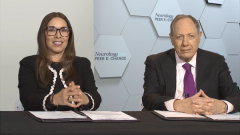
Progression of NMOSD Over Time
Experts in neurology discuss the progression of neuromyelitis optica spectrum disorder, focusing on acute relapse and pseudo attacks.
Episodes in this series

Brian Weinshenker, MD: Dr Nelson, can you tell us a bit about the evolution of NMOSD [neuromyelitis optica spectrum disorder]? There are relapses. Do we see progression in this condition as we do in multiple sclerosis [MS]?
Flavia Nelson, MD: Yes, we do. It’s similar to MS in terms of being relapsing remitting, but there is also progression independent of relapses. Most important, as I mentioned before, it seems to be less responsive to treatment in terms of steroid treatment and irreversible damage is commonly seen. So, there is progression related to relapses and progression, and it’s independent of relapses, especially in the spinal cord while the Wallerian anterograde and retrograde degeneration of axons occurs. That answers your question.
Aaron Miller, MD, FAAN: If I might interject, it’s my understanding that we very seldom see this kind of insidious progression that we see with MS. MS patients can get worse by failure to resolve relapses, but much more typical in MS is the later gradual progression, insidious progression without, or sometimes with superimposed relapses whereas the, typical NMO [neuromyelitis optica] patient is getting worse because they don’t recover from their relapses rather than having this insidious progression.
Brian Weinshenker, MD: I think that’s an excellent point that’s been described by a number of groups first at Mayo Clinic, that a distinguishing feature from MS is that most of the disability accumulation is relapse related. Would you agree with that, Dr Nelson?
Flavia Nelson, MD: I think at the beginning of the disease, yes, it’s very similar, but it gets to a point where you do see progression, especially when they’ve accumulated enough disability. But that depends on the patient as well.
Brian Weinshenker, MD: Bob, could you tell us a bit about how you would diagnose an acute relapse?
Robert Shin, MD, FAAN: Well, I think I might copy my thinking about how I would find an MS relapse in this instance. I usually try to emphasize if somebody has a new neurological symptom with some duration to it, and lasting for about 24 hours, and especially in someone who has a diagnosis of NMO spectrum disorder, I would certainly be concerned about basically new damage. That there’s a new area of inflammation somewhere in the brain or spinal cord or brainstem that is responsible for this new set of symptoms. And I would only really distinguish this from the possibility of an old symptom resurfacing from incomplete recovery.
I would add to the previous discussion that although I think Dr Nelson has a point, especially in the era before treatment for NMO spectrum disorder, that when patients became very disabled, there might be a threshold after which we see them begin to appear to insidiously decline. But I think I’m more in alignment with Dr Miller’s and your formulation that the primary driver of disability in NMO spectrum disorders are these relapses.
Flavia Nelson, MD: I absolutely agree with that, and especially when they’re not treated properly. I think that there’s a lot to say about the immediate treatment of relapses.
Brian Weinshenker, MD: Aaron, I wanted to ask you about the issue of pseudo relapse. And this is a problem we often face in patients with multiple sclerosis. Do you think it’s a problem in neuromyelitis optica? And what kind of investigations do you think we need to do in patients with neuromyelitis optica, say for example, MRIs?
Aaron Miller, MD, FAAN: Brian, I don’t think we have any good scientific data about the so-called pseudo relapses in NMOSD, and frankly, it’s not a term that I’ve seen applied much to relapses in NMOSD in contrast to MS where it’s pretty common. Pseudo relapses in MS, of course related to heat, to infection, to excessive fatigue, perhaps maybe to distress, whatever that is. And in NMO I’m sure it’s possible to worsen symptoms with fever and other things, but when I think in my experience the pseudo relapses in MS are usually relatively mild, and have a relatively short-lived recovery with the resolution of the precipitating event. Whereas NMO relapses are usually very severe. They’re usually accompanied by something that you can see on MRI either in the optic nerve or the spinal cord, where most of these episodes come and they don’t resolve so quickly. I don’t really think pseudo relapses is a major issue in NMOSD.
Transcript edited for clarity
Newsletter
Keep your finger on the pulse of neurology—subscribe to NeurologyLive for expert interviews, new data, and breakthrough treatment updates.







